The Bulldozer Review: AMD FX-8150 Tested
by Anand Lal Shimpi on October 12, 2011 1:27 AM ESTGaming Performance
AMD clearly states in its reviewer's guide that CPU bound gaming performance isn't going to be a strong point of the FX architecture, likely due to its poor single threaded performance. However it is useful to look at both CPU and GPU bound scenarios to paint an accurate picture of how well a CPU handles game workloads, as well as what sort of performance you can expect in present day titles.
Civilization V
Civ V's lateGameView benchmark presents us with two separate scores: average frame rate for the entire test as well as a no-render score that only looks at CPU performance.
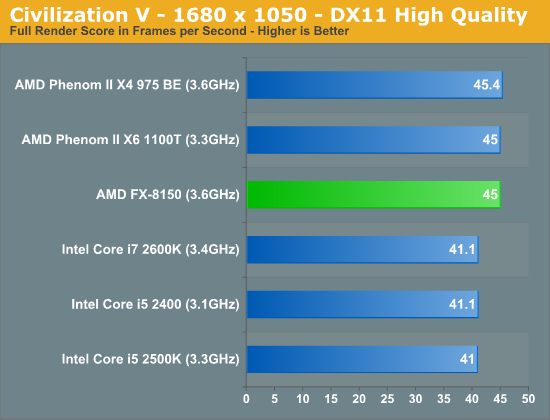
While we're GPU bound in the full render score, AMD's platform appears to have a bit of an advantage here. We've seen this in the past where one platform will hold an advantage over another in a GPU bound scenario and it's always tough to explain. Within each family however there is no advantage to a faster CPU, everything is just GPU bound.
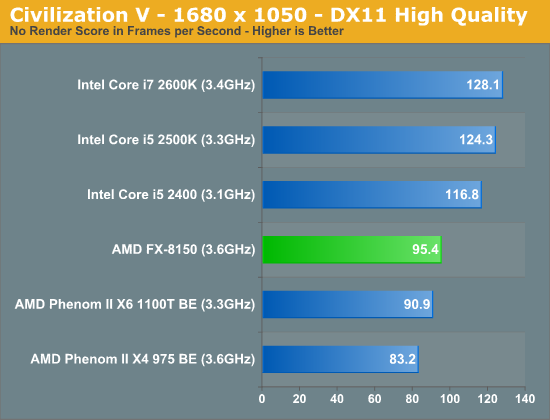
Looking at the no render score, the CPU standings are pretty much as we'd expect. The FX-8150 is thankfully a bit faster than its predecessors, but it still falls behind Sandy Bridge.
Crysis: Warhead
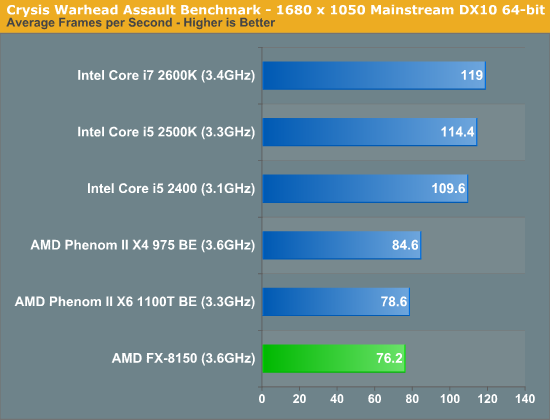
In CPU bound environments in Crysis Warhead, the FX-8150 is actually slower than the old Phenom II. Sandy Bridge continues to be far ahead.
Dawn of War II
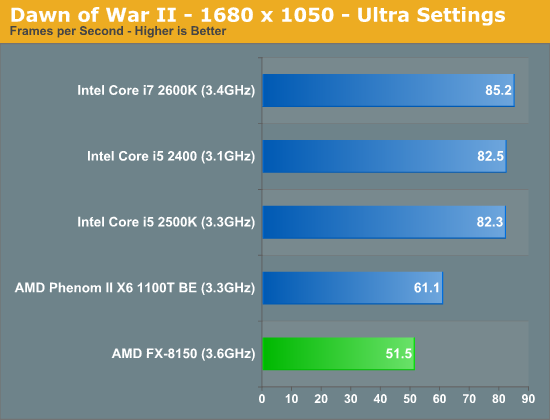
We see similar results under Dawn of War II. Lightly threaded performance is simply not a strength of AMD's FX series, and as a result even the old Phenom II X6 pulls ahead.
DiRT 3
We ran two DiRT 3 benchmarks to get an idea for CPU bound and GPU bound performance. First the CPU bound settings:
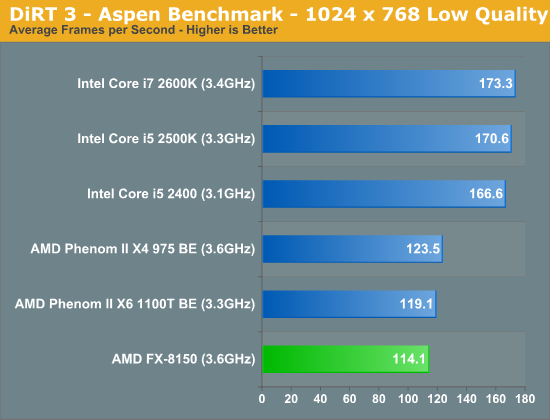
The FX-8150 doesn't do so well here, again falling behind the Phenom IIs. Under more real world GPU bound settings however, Bulldozer looks just fine:
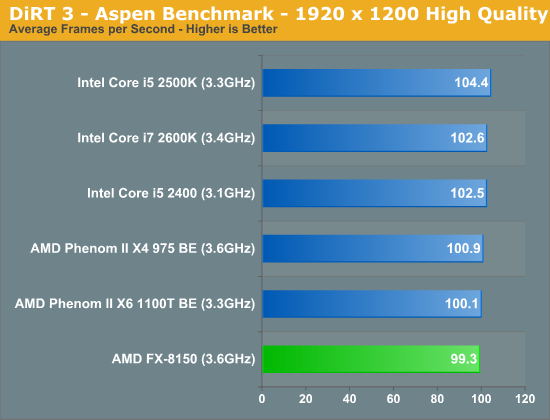
Dragon Age
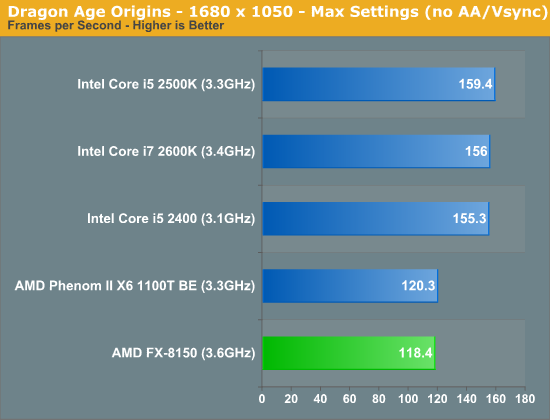
Dragon Age is another CPU bound title, here the FX-8150 falls behind once again.
Metro 2033
Metro 2033 is pretty rough even at lower resolutions, but with more of a GPU bottleneck the FX-8150 equals the performance of the 2500K:
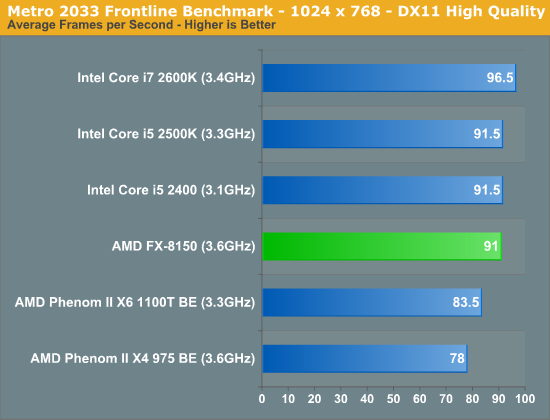
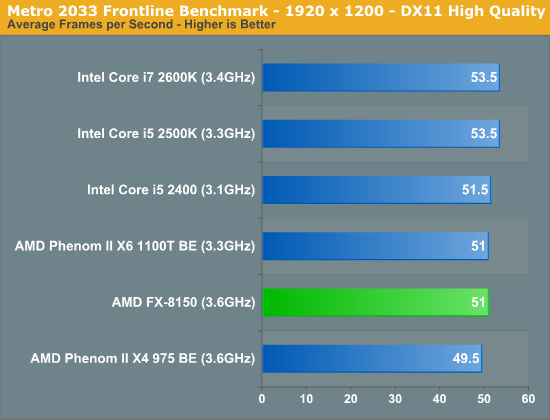
Rage vt_benchmark
While id's long awaited Rage title doesn't exactly have the best benchmarking abilities, there is one unique aspect of the game that we can test: Megatexture. Megatexture works by dynamically taking texture data from disk and constructing texture tiles for the engine to use, a major component for allowing id's developers to uniquely texture the game world. However because of the heavy use of unique textures (id says the original game assets are over 1TB), id needed to get creative on compressing the game's textures to make them fit within the roughly 20GB the game was allotted.
The result is that Rage doesn't store textures in a GPU-usable format such as DXTC/S3TC, instead storing them in an even more compressed format (JPEG XR) as S3TC maxes out at a 6:1 compression ratio. As a consequence whenever you load a texture, Rage needs to transcode the texture from its storage codec to S3TC on the fly. This is a constant process throughout the entire game and this transcoding is a significant burden on the CPU.
The Benchmark: vt_benchmark flushes the transcoded texture cache and then times how long it takes to transcode all the textures needed for the current scene, from 1 thread to X threads. Thus when you run vt_benchmark 8, for example, it will benchmark from 1 to 8 threads (the default appears to depend on the CPU you have). Since transcoding is done by the CPU this is a pure CPU benchmark. I present the best case transcode time at the maximum number of concurrent threads each CPU can handle:
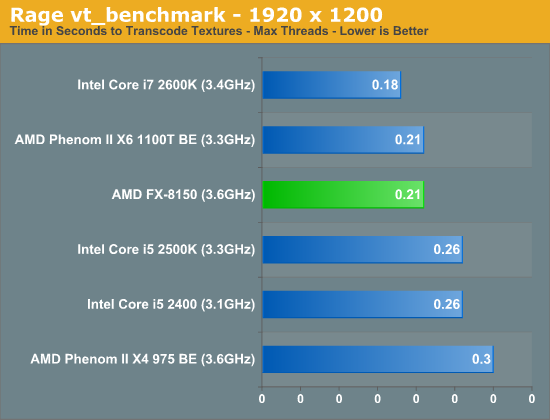
The FX-8150 does very well here, but so does the Phenom II X6 1100T. Both are faster than Intel's 2500K, but not quite as good as the 2600K. If you want to see how performance scales with thread count, check out the chart below:
Starcraft 2

Starcraft 2 has traditionally done very well on Intel architectures and Bulldozer is no exception to that rule.
World of Warcraft
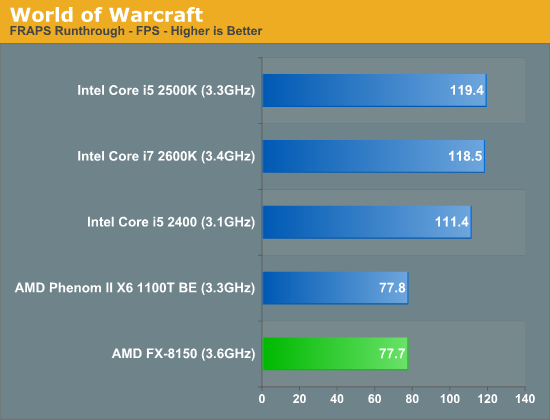


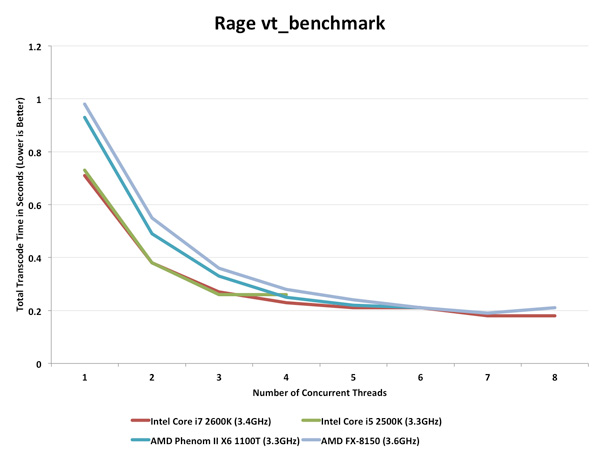








430 Comments
View All Comments
Ryan Smith - Wednesday, October 12, 2011 - link
Good point. Fixed.Marburg U - Wednesday, October 12, 2011 - link
they have a bloating cache with something wrong insidehttp://www.xbitlabs.com/images/cpu/amd-fx-8150/t5....
npp - Wednesday, October 12, 2011 - link
Sun went an even more extreme route regarding FP performance on its Niagara CPUs - as far as I remember, the first generation chip had a single FPU shared across eight cores. Performance was not even close to a dual-core Core 2 Duo at that time. So that was what I though when I first read about the "module" approach in Bulldozer maybe an year ago - man, this must be geared towards server workloads primary, it will suffer on the desktop. I guess FPU count = core count would have be more appropriate for the FX line.hasu - Wednesday, October 12, 2011 - link
Would this be a good candidate for web server applications because of its excellent multi-threaded performance? How about to host a bunch of Virtual Machines?sep332 - Wednesday, October 12, 2011 - link
I've also been wondering if running a lot of VMs would work better on this CPU. But I don't really know how you'd benchmark that kind of thing. Time and total energy consumption to serve 20,000 web pages from 12 VMs?magnetik - Wednesday, October 12, 2011 - link
I've been waiting for this moment for months and months.Reading the whole thing now...
themossie - Wednesday, October 12, 2011 - link
This processor is worse than the Phenom II X6 for most of my workloads. My next machine will be Sandy/Ivy Bridge.But... we haven't seen this clock ramp up yet. As Anand mentions on page 3 - Remember the initial Pentium 4s? The Williamette 1.4 and 1.5 ghz processors were clearly worse than the competition, to say nothing of the PIII line. In time the P4 consistently beat the much higher IPC AMD processors on most workloads, especially after introducing Hyper-threading. This really does feel like a new Pentium IV! Trying a design based on clock speed and one-upping Intel's hyperthreading by calling 4 '1.5' cores 8 (we hyperthread your hyperthreading!) - it will be a wild ride.
At this point, I don't see anyone beating Intel at process shrink and they're a moving target. But competitive pricing, quick ramp up and a few large server wins can still save the day. Dream of crazy clockspeeds :-)
themossie - Wednesday, October 12, 2011 - link
Upon further reflection...- Expect to see Bulldozer targeted towards servers and consumers who think "8 cores" sounds sexy, at least until clockspeed ramps up.
- Processor performance is not the limiting factor for most consumer applications. AMD will push APUs very heavily, something they can beat Intel at. Piledriver should drive a good price/performance bargain for OEMs, and for laptops may have idle power consumption in shouting distance of Sandy Bridge.
I'm more optimistic about AMD now. But my next machine will still be Sandy Bridge / Ivy Bridge.
wolfman3k5 - Wednesday, October 12, 2011 - link
I see people that say that they'll be waiting for Piledriver. Why not wait for AMD Drillbit, or AMD Dremel? How about AMD Screwdriver or AMD Nailpuller? Tomorrow my 2600K arrives. I'm done. I had a build ready with a ASUS 990FX ready for Bulldozer, but I will "bulldoze" the part back to NewEgg.I must admit, I was worried when I saw the large amounts of L2 cache before the launch. AMD engineers must have been taking the summer off, and decided to throw more cache at the problem. AMD needs a new engineering team. Why the hell can Intel get it right and they can't?
AMD, your CPU engineers are lazy and incompetent. I mean, it only took you "only" four years to get your own version of the Pentium 4.
The bottom line is that its time to fire your lazy retarded and incompetent engineers, and scout for some talent. That's what every other company does that wants to succeed, regardless of the industry. I mean, look at KIA and Hyundai for example, they went out and hired the best designers from Audi and the best engineers they could buy with money. Throw some more money at the problem AMD and solve your problems. And if those lazy fat fucks in Texas that you call engineers don't deliver, look somewhere else. Israel or Russia maybe? Who knows... Just my 2 cents.
IKeelU - Wednesday, October 12, 2011 - link
I know nothing of AMD employee's work ethic, but...their problems may have nothing to do with raw technical talent. But you are right about one thing - throwing money at a problem can be helpful, and that's likely why Intel has succeeded for so long. Intel has a lot of cash, and a lot of assets (such as equipment). They can afford the best design/debugging tools (whether they buy'em or make'em), which makes it much easier to develop a top product given the same amount of microchip engineering talent.And just because they're based in Texas doesn't mean their staff is all-American. Like most US tech firms, quite a bit of their talent was probably imported.